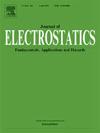脉冲电晕放电与等离子体后光催化联合深度氧化空气中间二甲苯
IF 2.1
4区 工程技术
Q3 ENGINEERING, ELECTRICAL & ELECTRONIC
引用次数: 0
摘要
本研究考察了塞流等离子体后催化空气净化系统去除空气中间二甲苯(40±5 ppm)的效率。处理系统由脉冲电晕放电(PCD)反应器和光催化氧化(PCO)反应器串联组成,以增强污染物的降解能力。实验在不同条件下进行,包括空气流速从2到10 m3 h - 1,相对湿度水平为2.5%(干燥空气),35%(潮湿空气)和65% (PCD反应器内喷头辅助加湿)。此外,PCD反应器的脉冲频率在每秒100到800脉冲之间变化,可以评估其对处理性能的影响。该研究深入了解了操作参数如何影响连续流系统中间二甲苯的降解效率。研究结果强调了等离子体后光催化在空气净化方面的协同潜力,以及臭氧、氮氧化物和副产品形成等潜在缺点。本文章由计算机程序翻译,如有差异,请以英文原文为准。

Advanced oxidation of airborne m-xylene in combination of pulsed corona discharge and post-plasma photocatalysis
This study investigates the efficiency of a plug flow post-plasma catalysis air purification system for the removal of m-xylene (40 ± 5 ppm) from air. The treatment system consists of a pulsed corona discharge (PCD) reactor followed by a photocatalytic oxidation (PCO) reactor, arranged in series to enhance pollutant degradation. Experiments were conducted under varying conditions, including air flow rates from 2 to 10 m3 h−1, and relative humidity levels of 2.5 % (dry air), 35 % (humid air), and 65 % (sprinkler-assisted humidification within the PCD reactor). In addition, the pulse frequency of the PCD reactor varied between 100 and 800 pulses per second, allowing evaluation of its influence on treatment performance. The study provides insight into how operational parameters affect the degradation efficiency of m-xylene in a continuous-flow system. The results highlight the synergistic potential of post-plasma photocatalysis for air purification and potential shortcomings like ozone, nitrogen oxides and by-product formation.
求助全文
通过发布文献求助,成功后即可免费获取论文全文。
去求助
来源期刊

Journal of Electrostatics
工程技术-工程:电子与电气
CiteScore
4.00
自引率
11.10%
发文量
81
审稿时长
49 days
期刊介绍:
The Journal of Electrostatics is the leading forum for publishing research findings that advance knowledge in the field of electrostatics. We invite submissions in the following areas:
Electrostatic charge separation processes.
Electrostatic manipulation of particles, droplets, and biological cells.
Electrostatically driven or controlled fluid flow.
Electrostatics in the gas phase.
 求助内容:
求助内容: 应助结果提醒方式:
应助结果提醒方式:


